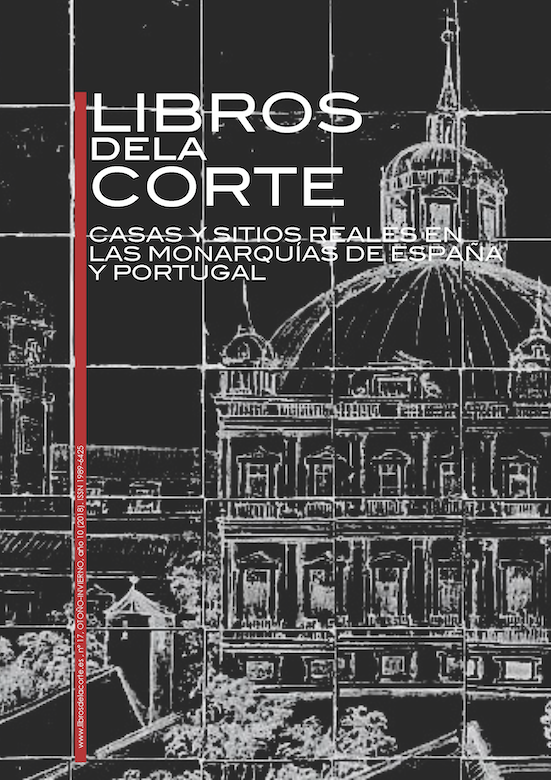COURT TOWNS AT THE SERVICE OF THE KING: SAN LORENZO DE EL ESCORIAL AND THE URBAN INTERVENTIONS OF CHARLES III
Keywords:
Architecture, Urbanism, Royal Places, 18th century, Historical heritageAbstract
During the 18th century, the Bourbon dynasty materialized in the Royal Places the transformation of the court system, through the creation of new cities, close to its residences. Aranjuez, La Granja de San Ildefonso, San Lorenzo de El Escorial and El Pardo will be the subject of large-scale urban operations, strengthened during the reign of Carlos III. He will carry out a methodical program in order to organize and dignify the royal stays. However, in San Lorenzo, the King found an important problem that compared to the other cases it seemed insuperable: a religious community considered itself custody of the will of the founder king Felipe II. This is way, the community was contrary to urbanize the environment of the Monastery. The perseverance of the King, ruthless in his idea, will achieve the success in the Royal Decree of 1767 for the construction of houses on the Site.
Downloads
References
Juan Antonio Álvarez de Quindós y Baena, Descripción histórica del Real Bosque y Casa de Aranjuez. Madrid, 1804. Facsímil Aranjuez: Doce Calles, 1993.
Teresa Arenillas, José Alberto Burgués y Miguel Lasso de la Vega, “El municipio de San Lorenzo de El Escorial. Siglo XVIII y casco histórico (s. XVI-XX)”, en Arquitectura y Desarrollo Urbano. Comunidad de Madrid (zona Oeste). El Escorial y San Lorenzo de El Escorial. Madrid: Comunidad de Madrid, Colegio Oficial de Arquitectos y Fundación Caja Madrid, 1998, tomo V, 177-216.
Mariano Bayón y José Luis Martín, Real Coliseo Carlos III. Madrid: Comunidad de Madrid, 1988.
Antonio Bonet Correa, “El Real Sitio y Villa de Aranjuez en el siglo XVIII: Arquitectura y Urbanismo”, en El Real Sitio de Aranjuez y el arte cortesano del siglo XVIII, catálogo de exposición. Aranjuez, Comunidad de Madrid y Patrimonio Nacional, abril-mayo 1987.
Miguel Lasso de la Vega Zamora, “Aranjuez, siglos XVII y XVIII”, en Arquitectura y Desarrollo Urbano. Comunidad de Madrid (zona Sur). Aranjuez. Madrid: Comunidad de Madrid, Colegio Oficial de Arquitectos y Fundación Caja Madrid, 2004, tomo IX, 61-103.
Miguel Lasso de la Vega Zamora y Vicente Górriz Burk, “La Recuperación del plano topográfico de 1794 de San Lorenzo de El Escorial”, Reales Sitios XXXII 125 (3º trimestre 1995).
José Luis Martín Gómez, La fundación y orígenes de la población del Real Sitio de San Lorenzo, en Población y Monasterio (El Entorno), catálogo de exposición. Madrid: Comunidad Autónoma de Madrid, 1986.
Pedro Moleón Gavilanes, La arquitectura de Juan de Villanueva. El proceso del proyecto.
Madrid: Colegio Oficial de Arquitectos de Madrid, 1988.
Antonio Ponz, Viaje de España, Tomo II. Madrid, 1788.
Fray José de Quevedo, Historia del Real Monasterio de San Lorenzo del Escorial. Madrid, 1849.
Carlos Sambricio y Maira Herrero, “Las intervenciones de Juan de Villanueva en el Real Sitio de San Lorenzo de El Escorial”, Fragmentos 12-13-14 (junio-1988): 189-205.
José Luis Sancho Gaspar, La arquitectura de los Sitios Reales. Madrid: Patrimonio Nacional y Fundación Tabacalera, 1995.
Virginia Tovar Martín, “El arquitecto italiano Santiago Bonavía y trazado de la ciudad de Aranjuez”, Anales del Instituto de Estudios Madrileños, XXXVII (1997).
Manuel Valenzuela Rubio, “El Escorial: De Real Sitio a núcleo turístico-residencial”,
Anales del Instituto de Estudios Madrileños X (1974).
